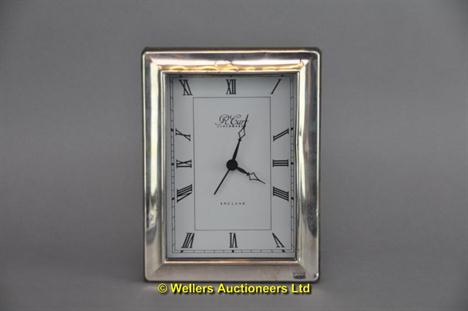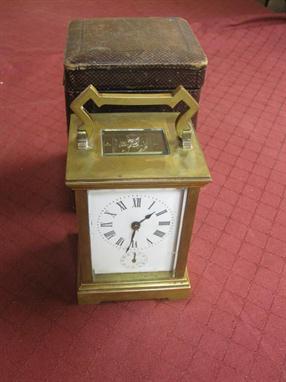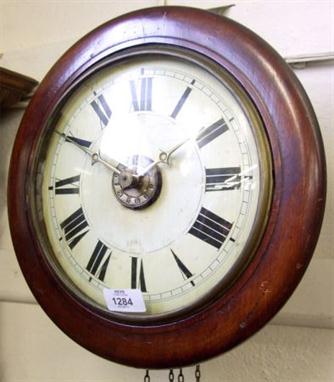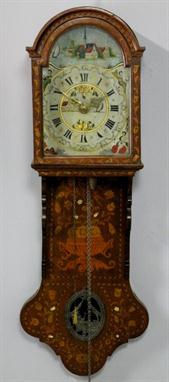An 18th Century brass thirty hour bell strike clock movement, the break arch dial with single hand and alarm setting disc framed by a silvered chapter ring with Roman numerals and lozenge half hour marks, beneath a silvered boss inscribed `Philip Greathead, London`, cornered with pierced mask and scroll spandrels, the later mahogany wall clock case with arched pediment and glazed door, dial width approx 14cm, together with pendulum and two weights.
14361 Preisdatenbank Los(e) gefunden, die Ihrer Suche entsprechen
14361 Lose gefunden, die zu Ihrer Suche passen. Abonnieren Sie die Preisdatenbank, um sofortigen Zugriff auf alle Dienstleistungen der Preisdatenbank zu haben.
Preisdatenbank abonnieren- Liste
- Galerie
-
14361 Los(e)/Seite
A good engraved oval striking carriage clock with alarum, white enamel dial signed Chancellor & Son, Dublin, subsidiary alarm dial against an engraved gilt mask, bell striking movement numbered 2077 with original lever platform, in a well engraved case, the numbered key contained in the bottom section of the oval travelling case, 14.5cm h.
A mid-Victorian French engraved oval carriage clock having an eight-day duration movement with cylinder escapement, striking the hours and half-hours on a bell with push repeat and alarm, the white enamel dial with black Roman numerals, blued steel spade hands and a subsidiary alarm setting disc, the oval brass case with engraved decoration to the case and handle, height: 18cm (handle up); 15cm (down)
Angel Sparke, Plymouth, a ‘rocking-ship’ longcase clock having an eight-day duration movement striking the hours on a bell, with additional alarm work to the side, the 11½ inch silvered arched dial engraved with black Roman numerals and subsidiary seconds dial, date aperture, blued steel hands and alarm setting disc to the centre, engraved with rococo decoration to the four corners and signed to the dial centre ‘Angel Sparke, Plymouth’, the arch having a rocking ship automaton with a sea-battle scene painted behind, the mahogany case with fluted canted corners and an arched door to the trunk, fluted columns with brass capitals to the arched hood and surmounted by three brass ‘eagle & ball’ finials, height: 214cm. * Angel Sparke is recorded as working in Plymouth from before 1792 when it was reported in the Exeter Gazette that ‘some villains broke open the shop of Mr. A. Sparke, watchmaker of Plymouth and plundered it of several articles’. The St. Andrews Church of Plymouth records him working on the church clock between 1786 and 1797 and he was known to be working at Market Street in 1814.
A cigarette lighter and cigarette packet holder, in gilt metal, the packet case with a paste and simulated pearl `catch`; a suite of paste set items, `Styled By Schildkraut`, comprising cigarette case, comb, with case and mirrored to the reverse, a pill box, and a musical key ring; an Appella paste and simulated pearl alarm clock, one pearl deficient; and a simulated snake skin box
Cartier, a lacquer and gilt metal oval alarm clock, no. 15958, ref. 7509, the signed white dial with black Roman numerals and hands, the bezel lacquered to simulate malachite, the back with hour and alarm buttons set with synthetic sapphires, the easel with Cartier C feet, 9cm high, in a Cartier box
Cartier, a stainless steel square desk alarm clock, no. 101690GD, ref. 2745, the signed black square dial with white Roman numerals and part white steel hands, in a polished steel bezel, the case with a facetted black onyx to the top and brushed overall, the back with hour and alarm buttons set with synthetic sapphires, 7cm, in a Cartier pouch
An Edwardian gent`s silver vesta / sovereign case, Birmingham, c.1906. of rounded rectangular form, height 6.5 cm with two ladies wristwatches, together with miscellaneous items to include, a gilt metal card case, a travelling alarm clock, a heuer pocket timer, a gilt metal compact, two lighters, wooden hinged box, two monocles and a cased set of six white metal engraved goblets (a lot).
1930s travelling alarm clock with eight day Swiss movement, silvered dial with pierced hands by Zenith Watch Co in a gilded case of architectural form in the Art Deco style, engine-turned decoration on four bracket feet in original blue leather carrying case, clock 9cm overall height Further images and condition reports available at www.reemandansie.com
Late nineteenth French carriage clock with eight day alarm movement striking on a gong, white enamel dial with subsidiary alarm, dial in a brass case with square section scroll carrying handle, 18cm overall height including handle Further images and condition reports available at www.reemandansie.com
Nineteenth century carriage clock with eight day alarm movement, signed D H White, enamel dial and subsidiary alarm dial with ornate grape and vine mask in an ornate case with pierced decoration and four fluted pillars, with turned carrying handle on four brass feet, 15cm overall height Further images and condition reports available at www.reemandansie.com
A mid-19th Century Mahogany Cased Postman’s Alarm Clock, the mahogany surround to a spun brass bezel, convex glass enclosing a painted Roman dial with outside minute track and signed to the centre “Sihuler -16 City Road”, with cast brass hands and central alarm disc, to a twin weight driven movement with anchor escapement and strike on a bell (A/F), width 12 ½”
A 19th century French gilt brass carriage clock, glazed bevelled panels, the white enamel dial with Roman numerals and subsidiary alarm marked with Arabic numerals, the 8-day twin train movement with quarter repeat button striking on twin gongs, stamped J.D. (probably Dejardin), no.6443, in original red morocco travel case, c/w numbered key, 6.5 cm high
A LATE 19TH CENTURY FRENCH GILT BRASS CARRIAGE CLOCK by Oudin-Charpentier, Paris, c. 1880, with an eight day alarm movement, striking on the full and half hour, the enamel two-part dial with Arabic numerals, subsidiary dial below, within a gilt fascia, maker`s mark stamped on the backplate, 14.5cms high handle down. See illustration
A late 19th/early 20th Century Black Forest softwood wall clock, the white painted chapter ring with black gothic Roman numerals, together with a Dutch wall alarm clock, the dial decorated with a scene of a courting couple to the arch above Roman numerals, together with a pendulum and three weights (faults).
A French brass gorge cased carriage clock with push-button repeat and alarm, Unsigned but attributable to either Jacot or Drocourt, Paris, circa 1875. The eight-day two train bell striking movement with original gilt platform lever escapement and numbered 2340 to backplate, the rectangular white enamel Roman numeral dial with subsidiary alarm setting dial beneath to lower margin, the lacquered bevel-glazed case with hinged carrying handle and repeat serial number to base, 13cm high excluding handle. The platform lever escapement used on the current lot with its distinctive right-angled lever layout, `butterfly` endpiece and shaped tail can be directly compared with an example as used by Jacot and Drocourt illustrated in Allix, Charles and Bonnert, Peter CARRIAGE CLOCKS, Their history and development on page 114.
A Germanic gilt brass small hexagonl horizontal table clock with alarm, C.L. Leysaht, Zittau, early 18th century. The six pillar rack and bell striking movement with fusee and verge escapement regulated by a monometallic sprung balance to going train, the strike train with standing barrel and sounding on a bell mounted within the base of the case, the alarm train with further standing barrel and verge operated hammer on the same bell, the backplate with foliate scroll pierced balance bridge, silvered regulation dial and signed C L Lesaht, Zittau to one edge, the dial with pewter alarm setting disc within conforming applied 3 inch Roman numeral chapter ring with Arabic five minutes to outer track, with steel beetle-and-poker hands, the horizontal case with caddy moulded dial surround above glazed sides divided by line-engraved pilasters to angles, on cavetto moulded base with six disc turned feet, (strike train with replacements), 10cm (4ins) wide.
A fine Charles II lantern clock, Richard Ames, London, circa 1680. The posted countwheel bell-striking movement with verge escapement and pendulum swinging within the frame of the clock between the trains and additional passing half-hour strike mounted behind the dial, the dial engraved with signature Richard Ames Neere St. Andrews Church in Holburn fecit in a curve towards the upper margin of the dial centre and with foliate tulip decoration to lower margin, with original iron hand and applied narrow Roman numeral chapter ring with wheatear half hour markers, the standard London third period `Lothbury` frame with column turned posts beneath dolphin engraved and pierced frets, vase turned finials and domed bell bearer, the side doors cut with slots to allow for the swing of the arrow shaped centre pendulum, the rear with iron hanging loop, on ball feet, (alarm removed), 38cm (15ins) high. Richard Ames is recorded in Loomes, Brian The Early CLOCKMAKERS of Great Britain as being born circa 1634, he was apprenticed to Peter Closon in 1648/9 and gaining his Freedom of the Clockmakers` Company in 1656/7. He was made Assistant in 1669, Warden 1676-81 and was elected master in September 1682 only to die the following month. His widow Katherine perhaps assisted by their son, William, continued the business until at least 1692. He had many apprentices, the most significant of which perhaps being John Ebsworth (Freed Apr. 1665) who became a fine maker of lantern clocks in his own right. The work of Richard Ames is discussed in Loomes, Brian LANTERN CLOCKS & Their Makers pages 127-134 where two very similar clocks to the current lot are comprehensively described and illustrated (figs. 9.5-11). All of these three examples share the same unusual features (passing half-hour strike and separately wound trains), and can be compared to another illustrated in Darken, Jeff and Hooper, John English 30 Hour Clocks pages 47-50 which only differs in not having passing half-hour strike.
A William III brass lantern clock with ten inch square brass dial, Daniel Quare, London, circa 1695. The posted countwheel bell-striking movement with column turned corner uprights and now with anchor escapement, the 10 inch square brass dial with matted centre within an applied silvered Roman numeral chapter ring with stylised sword hilt half hour markers and signed Dan Quare, London to lower edge, with original steel hand and angles applied with winged cherub head and scroll cast spandrels, the frame with foliate pierced side frets and vase turned finials beneath domed bell bearer above, with rear hanging hoop and spurs to the turned ball feet, (lacking one side door and alarm) 40cm (16.75ins) high. Daniel Quare was admitted as Brother of the Clockmakers` Company in April 1671 and by 1683 he was working from Exchange Alley, London. He was selected as a member of the Court of Asssistants in 1698, later becoming Master in 1708. The following year he took a former apprentice, Stephen Horseman, into partnership which presumably lasted until Quare`s death in 1724. He was a fine inventive and commercially-minded maker who supplied clocks to significant European Royal and Aristocratic clients as well the Court of William III. As a Quaker, Quare refused an invitation from George I to be appointed `Royal Clockmaker` as his beliefs would not allow him to undertake the Oath of Allegiance, however an informal arrangement was agreed where Quare had open access to the palace via the back stairs. In addition to clocks, Quare is also famous for his `portable weather glass` or pillar barometer for which he sought a patent via the Clockmakers` Company in 1695. After his death in 1724 he was buried at the Quaker`s burial ground at Bunhill Fields.
*A George I ebonised table clock with pull quarter repeat and alarm, Andrew Dunlop, London, circa 1725. The five finned pillar twin fusee bell striking movement with verge escapement, pull quarter repeat on six bells and alarm sounding via two small hammers on the hour bell, the backplate engraved with a basket of flowers flanked by ho-ho birds within foliate scrolls and a herringbone decorated border, the 7.5 inch brass break-arch dial with subsidiary calendar and false bob apertures and signed And:r Dunlop, London to a burnished oval cartouche to the matted centre within an applied silvered Roman numeral chapter ring with fleur-de-lys half hour markers and Arabic five minutes to outer track, the angles with applied female mask and scroll pattern spandrels and N/S switch at 9 o`clock beneath arch with rosette-centred silvered Arabic numeral alarm setting dial with blued steel pointer flanked by Indian mask and scroll cast mounts, the inverted bell top case with hinged carrying handle and brass finials above scroll pierced frets to the upper quadrants of the front door and break-arch side windows, the rear door with demi-line scroll-pierced sound fret above rectangular glazed panel, on cavetto moulded base with squab feet, 45cm (17.5ins) high excluding handle. Andrew Dunlop is recorded in Baillie G.H. Watchmakers & Clockmakers of the World as working in London 1701-32.
A late 19th Century Mahogany Postman’s Alarm Clock, the plain moulded surround to a cast brass bezel with convex glass enclosing a 9” painted wooden dial with Roman chapter ring and outside minute track with cast brass hands and central alarm set disc, to a twin weight-driven wooden movement with anchor escapement and strike on a bell, diameter 12 ½”
-
14361 Los(e)/Seite















































